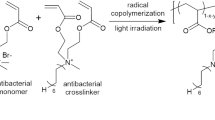Abstract
A novel furanone-containing antibacterial resin composite has been prepared and evaluated. compressive strength (CS) and Streptococcus mutans viability were used to evaluate the mechanical strength and antibacterial activity of the composites. The modified resin composites showed a significant antibacterial activity without substantially decreasing the mechanical strengths. With 5–30 % addition of the furanone derivative, the composite kept its original CS unchanged but showed a significant antibacterial activity with a 16–68 % reduction in the S. mutans viability. Further, the antibacterial function of the new composite was not affected by human saliva. The aging study indicates that the composite may have a long-lasting antibacterial function. Within the limitations of this study, it appears that the experimental antibacterial resin composite may potentially be developed into a clinically attractive dental restorative due to its high mechanical strength and antibacterial function.






Similar content being viewed by others
References
Mjor IA, Dahl JE, Moorhead JE. Placement and replacement of restorations in primary teeth. Acta Odontol Scand. 2002;60:25–8.
Forss H, Widstrom E. Reasons for restorative therapy and longevity of restorations in adults. Acta Odontol Scand. 2004;62:82–6.
Manhart J, Garcia-Godoy F, Hickel R. Direct posterior restorations: clinical results and new developments. Dent Clin North Am. 2002;46:303–39.
Deligeorgi V, Mjor IA, Wilson NH. An overview of reasons for the placement and replacement of restorations. Prim Dent Care. 2001;8:5–11.
Craig RG, Power JM. Restorative dental materials. 11th ed. St. Louis: Mosby-Year Book, Inc.; 2002. p. 614–8.
Wiegand A, Buchalla W, Attin T. Review on fluoride-releasing restorative materials—fluoride release and uptake characteristics, antibacterial activity and influence on caries formation. Dent Mater. 2007;23:343–62.
Osinaga PW, Grande RH, Ballester RY, Simionato MR, Delgado Rodrigues CR, Muench A. Zinc sulfate addition to glass-ionomer-based cements: influence on physical and antibacterial properties, zinc and fluoride release. Dent Mater. 2003;19:212–7.
Takahashi Y, Imazato S, Kaneshiro AV, Ebisu S, Frencken JE, Tay FR. Antibacterial effects and physical properties of glass-ionomer cements containing chlorhexidine for the ART approach. Dent Mater. 2006;22:647–52.
Yamamoto K, Ohashi S, Aono M, Kokubo T, Yamada I, Yamauchi J. Antibacterial activity of silver ions implanted in SiO2 filler on oral Streptococci. Dent Mater. 1996;12:227–9.
Syafiuddin T, Hisamitsu H, Toko T, Igarashi T, Goto N, Fujishima A, Miyazaki T. In vitro inhibition of caries around a resin composite restoration containing antibacterial filler. Biomaterials. 1997;18:1051–7.
Gottenbos B, van der Mei HC, Klatter F, Nieuwenhuis P, Busscher HJ. In vitro and in vivo antimicrobial activity of covalently coupled quaternary ammonium silane coatings on silicone rubber. Biomaterials. 2002;23:1417–23.
Thebault P, Taffin de Givenchy E, Levy R, Vandenberghe Y, Guittard F, Geribaldi S. Preparation and antimicrobial behaviour of quaternary ammonium thiol derivatives able to be grafted on metal surfaces. Eur J Med Chem. 2009;44:717–24.
Imazato S, Russell RR, McCabe JF. Antibacterial activity of MDPB polymer incorporated in dental resin. J Dent. 1995;23:177–81.
Murata H. Permanent, non-leaching antibacterial surfaces—2: how high density cationic surfaces kill bacterial cells. Biomaterials. 2007;28:4870–9.
Guiqian Lu, Dingcai Wu, Ruowen Fu. Studies on the synthesis and antibacterial activities of polymeric quaternary ammonium salts from dimethylaminoethyl methacrylate. React Funct Polym. 2007;67:355–66.
Lee SB, Koepsel RR, Morley SW, Matyjaszewski K, Sun Y, Russell AJ. Permanent, non-leaching antibacterial surfaces 1. Synthesis by atom transfer radical polymerization. Biomacromolecules. 2004;5:877–82.
Li F, Chai ZG, Sun MN, Wang F, Ma S, Zhang L, Fang M, Chen JH. Anti-biofilm effect of dental adhesive with cationic monomer. J Dent Res. 2009;88:372–6.
Li F, Chen J, Chai Z, Zhang L, Xiao Y, Fang M, Ma S. Effects of a dental adhesive incorporating antibacterial monomer on the growth, adherence and membrane integrity of Streptococcus mutans. J Dent. 2009;37:289–96.
Beyth N, Yudovin-Farber I, Bahir R, Domb AJ, Weiss EI. Antibacterial activity of dental composites containing quaternary ammonium polyethylenimine nanoparticles against Streptococcus mutans. Biomaterials. 2006;27:3995–4002.
Weng Y, Guo X, Chong VJ, Howard L, Gregory RL, Xie D. Synthesis and evaluation of a novel antibacterial dental resin composite with quaternary ammonium salts. J Biomater Sci Eng. 2011;4:147–57.
Imazato S, Ebi N, Takahashi Y, Kaneko T, Ebisu S, Russell RRB. Antibacterial activity of bactericide-immobilized filler for resin-based restoratives. Biomaterials. 2003;24:3605–9.
Ebi N, Imazato S, Noiri Y, Ebisu S. Inhibitory effects of resin composite containing bactericide-immobilized filler on plaque accumulation. Dent Mater. 2001;17:485–91.
Jung JH, Pummangura S, Chaichantipyuth C, Patarapanich C, Fanwick PE, Chang CJ, Mclaughlin JL. New bioactive heptenes from Melodorum fruticosum (Annonaceae). Tetrahedron. 1990;46:5043–54.
Jones JB, Young JM. Carcinogenicity of lactones III: the reactions of unsaturated 4-lactones with l-cysteine. J Med Chem. 1968;11:1176.
Lattmann E, Dunn S, Niamsanit S, Sattayasai N. Synthesis and antibacterial activities of 5-hydroxy-4-amino-2(5H)-furanones. Bioorg Med Chem Lett. 2005;15:919–21.
Xie D, Faddah M, Park J-G. Novel amino acid modified zinc polycarboxylates for improved dental cements. Dent Mater. 2005;21(8):739–48.
Xie D, Feng F, Chung I-D, Eberhardt AW. A hybrid zinc–calcium–silicate polyalkenoate bone cement. Biomaterials. 2003;24(16):2749–57.
Acknowledgments
This work was sponsored by NIH challenge grant (RC1) DE020614.
Author information
Authors and Affiliations
Corresponding author
Rights and permissions
About this article
Cite this article
Weng, Y., Howard, L., Guo, X. et al. A novel antibacterial resin composite for improved dental restoratives. J Mater Sci: Mater Med 23, 1553–1561 (2012). https://doi.org/10.1007/s10856-012-4629-z
Received:
Accepted:
Published:
Issue Date:
DOI: https://doi.org/10.1007/s10856-012-4629-z




